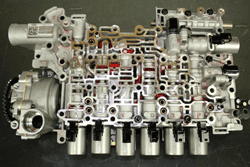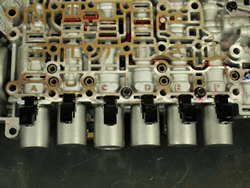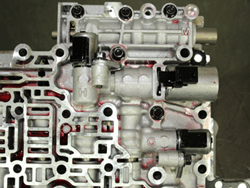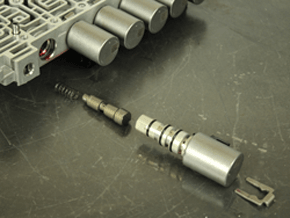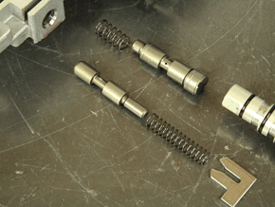The Heartbeat of the Transmission
How solenoid, hydraulic interaction achieves a specific gear and diagnostic tips- all in this article!
The Pump
With the pump being the heartbeat of the transmission and pumping fluid into its veins, it brings to life eight forward speeds, converter clutch apply and reverse. This article will provide a glimpse as to how the solenoids interact with the hydraulics to achieve a specific gear. It will also provide an example of diagnostics should a problem develop.
| Beginning with the solenoids, there are a total of nine on the valve body, as seen in Figure 8. There is an assigned letter in the casting for each of the solenoids, as seen in Figures 2 and 3. Here is where some confusion may occur, as the solenoids are primarily referred to by their function and by a number, not their letter. |
To clear up any possible confusion, the identification of the solenoids is listed as follows: VB casting letter is listed first, followed by its function. In parenthesis is the solenoid number associated with diagnostic trouble codes.
- A is the TCC Control Solenoid (Solenoid 7)
- B is the 2-3-4-6-8 Control Solenoid (Solenoid 4)
- C is the 1-3-5-6-7 Control Solenoid (Solenoid 3)
- D is the 4-5-6-7-8 Reverse Control Solenoid (Solenoid 5)
- E is the 1-2-7-8 Reverse Control Solenoid (Solenoid 1)
- F is the 1-2-3-4-5 Reverse Control Solenoid (Solenoid 2)
- G is the Default Control Solenoid (Solenoid 8)
- H is the 1-2-3-4-5 Reverse Boost Solenoid (Solenoid 9)
- J is the Line Pressure Control Solenoid (Solenoid 6)
| Five of these solenoids are supplied with a fixed reduced pressure feed called the Actuator Feed oil. They are solenoids D, E, G, H and J. The remaining four solenoids — A, B, C and F — are supplied with Line Pressure.The Actuator Feed valve in previous GM transmissions is known to wear its bore, causing a loss of solenoid supply pressure. Should this happen with the 8L90, it will have quite an undesirable effect in both forward and reverse ranges.
The solenoids that receive line pressure (A, B, C and F) will regulate that pressure to a lower pressure with which to regulate their respective control valves. These control valves sit forward of the solenoid inside the valve body and are also supplied with line pressure. |
When the solenoid influences its control valve, it regulates the valve to control line pressure to the clutch. For example, the 1-2-3-4-5 Reverse Control Solenoid (F) regulates its 1-2-3-4-5 Reverse Control valve in the valve body located directly in front of the solenoid. If a problem with this circuit fails, P0776 or P0777 may set.
The system description for codes P0776 and P0777 provided by GM is as follows:
The transmission control solenoid 2 is a high pressure, normally low, variable force solenoid. The transmission control solenoid valve 2 regulates and directs pressurized oil to the 1-2-3-4-5-Reverse Clutch assembly to apply the clutch. The transmission control module (TCM) uses information from the speed sensors along with serial data information from other control modules to calculate the correct gear ratio and apply the correct clutch assemblies. The TCM compares the calculated ratio to the commanded gear ratio. The calculated and commanded gear ratios must match. |
When they do not, depending on the failure, either P0776 or P0777 will set. These codes are defined as:
- DTC P0776 – Transmission Control Solenoid Valve 2 Stuck Off – The 1-2-3-4-5-Reverse Clutch did not apply due to a hydraulic/mechanical condition. This results in a neutral condition.
- DTC P0777 – Transmission Control Solenoid Valve 2 Stuck On – The 1-2-3-4-5-Reverse Clutch did not release due to a hydraulic/mechanical condition. This results in a tie-up condition.
| These are type A codes which will cause the TCM to disable transmission adaptation and will freeze current adapt values. It will disable Tap Up/Tap Down control and converter clutch apply. It will also request the ECM to disable powertrain braking, neutral idle control, auto grade braking, and auto stop function. The TCM will command a default shift pattern and ignore all other requests. In this case, the command for P0776 is 6th gear and reverse only while P0777 will be 2nd gear and reverse only. |
| The order of diagnostics would be to first check the O-rings on the S2 (F) solenoid and then inspect the solenoid to see if it has failed mechanically being stuck in the low or high position (Figure 4). The next step would be to inspect the condition of the 1-2-3-4-5-Reverse Control Valve in front of the solenoid in the valve body to see if it is stuck or if the bore is wore (Figure 5). The next step would be to refer to a hydraulic to see if there are any other valves or check balls in the circuit which would require inspection. In this example, the pressure being sent to the 1-2-3-4-5-Reverse clutch from the regulating valve is also going to the 1-2-3-4-5-Reverse Clutch Boost valve. This too will also need to be inspected (Figure 6). If all these items pass inspection, it’s time to go into the transmission and check the clutch assembly and piston seals. |
We will be continuing this article in another post next week. Look for the following information then. Like, share and comment below!


